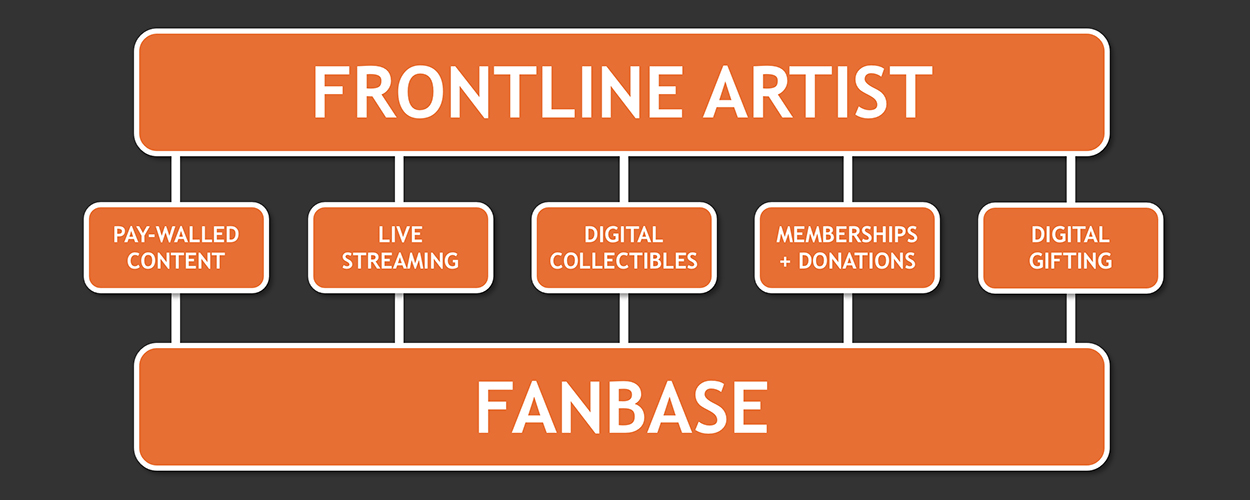CMU LIBRARY
The Direct-To-Fan Business
Resources about the direct-to-fan business

The direct-to-fan business is the newest strand of the wider music industry, focused on helping artists to better monetise the fan relationship through artist stores and by offering premium digital content and experiences.
BUILDING A FRONTLINE ARTIST BUSINESS
Any frontline artist who wants to make a full-time living from their music needs to build a business around their songs, their recordings, their performances and their fanbase – which is to say a frontline artist business.
Every frontline artist business has pretty much the same business plan. First, you build a fanbase. Second, you use data and analytics to understand your fanbase. And then third, you sell them stuff.
Traditionally the music industry had three main products that it sold to fans: records, tickets and t-shirts. You would sell lots of records. Some of the people who bought the record would also buy a ticket to the gig. And some of the people who came to the gig would also buy a t-shirt.
But what if you have a fanbase who don’t buy records (or don’t pay to stream), won’t spend much on tickets and aren’t interested in your t-shirts?
In the old music business, you would struggle to succeed if you couldn’t sell records, tickets and/or t-shirts. But in the modern music business – where you can be directly connected to your core fanbase online – you simply need to figure out what they will spend money on. Then sell that to them.
THE DIRECT-TO-FAN RELATIONSHIP
The single biggest impact the rise of digital has had on the music industry isn’t downloads, streaming or user-generated content – or iTunes, Spotify or YouTube – it is the online direct-to-fan relationship.
Pre-digital, most artists didn’t know who was consuming their music. Between the artist and the fans were record labels and retailers on the recorded side, and promoters and ticket agents on the live side.
Digital changes that. An artist is now directly connected to their core fanbase. Yes there are still digital platforms that often sit in the middle, but the modern fan relationship is much more direct and much more flexible.
This direct-to-fan connection opens up many new opportunities to monetise the fan relationship. The challenge is to figure out what products and services any one fanbase wants, and then how to deliver those products and services.
DIRECT-TO-FAN PLATFORMS
There are many digital platforms and tools that artists now use to build and monetise the fanbase, including social media; email; e-commerce, membership, patronage and fan-funding platforms; and digital gifting tools.
Some of these platforms and tools mainly help to build and understand a fanbase, while others enable the monetisation of the fan relationship by encouraging and enabling fans to spend money with the artist.
ARTIST STORES
When the music industry first started capitalising on the direct-to-fan relationship, the priority was often online artist stores, selling physical releases, merchandise and sometimes digital content directly-to-the fanbase, often involving premium and limited edition products.
Artists can reduce the financial risk of this activity by employing print-on-demand technologies. Or by running fan-funding or pre-order campaigns where fans are encouraged to commit to buy products or services in advance, often while an artist is still recording an album or planning a tour.
DIGITAL CONTENT AND EXPERIENCES
In more recent years more artists have started to provide premium digital content and experiences to the core fanbase through online fan clubs or membership schemes. Meanwhile many social media and user-upload platforms have started adding membership and digital-gifting tools.
Across the industry, this activity has really started to gain momentum, in part aided by the fact that other kinds of online creators – many of whom traditionally relied on ads, advertorial and product placement for income – are now also selling memberships and utilising digital gifting. This means fans are increasingly accustomed to spending money in this way.
THE DIRECT-TO-FAN BUSINESS
The direct-to-fan strand of the music industry is the least developed. For many artists, management will play a key role in direct-to-fan activity, although the label, merchandiser and/or promoter may also get involved.
The direct-to-fan sector also includes all the companies that provide the digital platforms and tools. Some of those are music-orientated like Bandcamp, Music Glue, FanCircles, ReverbNation and Bandzoogle.
Others are not music-specific but are used a lot in the music industry like Patreon, Kickstarter and Shopify. And, as noted, many social media and user-upload platforms increasingly offer direct-to-fan tools as well.
There are also an increasing number of D2F experts – sometimes standalone, sometimes within management companies or record labels – who can help artists with their direct-to-fan strategies, including crunching all the fan data now available, and identifying the best products, services and platforms for each artist to offer and utilise. They may also then help run this activity.
You will find coverage of all the key developments in and announcements from the D2F business in the Digital & D2F Services section of CMU.
This CMU:DIY Guide on Building A Fanbase looks at how early-career artists go about kick-starting the fanbase building process, and the key marketing tools, tactics and channels they employ.
The CMU:DIY Guide Music Data Explained looks at all the kinds of fan data that can help an artist build a fanbase and grow their own artist business.
The Digital Dollar Fan Data Guide from CMU Insights and the UK’s Music Managers Forum runs through all the key kinds of fan data, and explains how to use that data to build a successful artist business.
LAST UPDATED: July 2022




